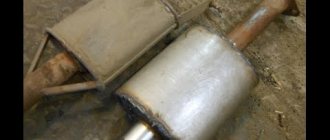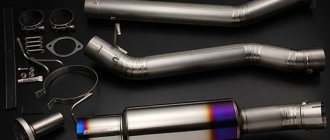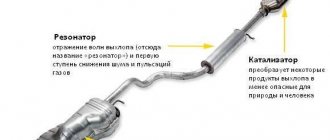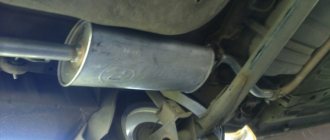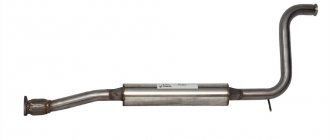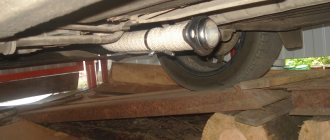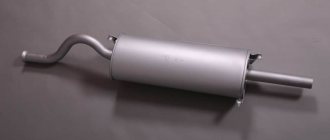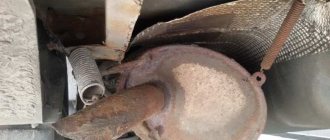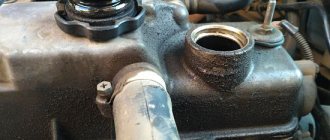Autolikbez August 30, 2017
While driving, the crankshaft of a car engine makes from 1.5 to 5–7 thousand revolutions per minute. Accordingly, 25–120 flashes and micro-explosions of fuel occur in the cylinders every second. As a result, piston-pushing energy, exhaust gases and powerful sound waves are released. To eliminate the loud rumble and noise from the exhaust pipe, which causes inconvenience to the driver and others, a sound-absorbing device was invented - a muffler. Since it does not last forever, it will be useful for car enthusiasts to know how this element works and whether it can be repaired in the event of a malfunction.
Where is the element located and what does it look like?
The main source of noise is the combustion chambers of a running engine. The sound waves generated there cannot penetrate through solid metal walls and tend to exit along the path of least resistance - through the exhaust pipe along with the exhaust gases. There a muffler is installed in the form of a metal barrel of a round or oval shape.
The operating diagram of a car exhaust system looks like this:
- A vibration-isolating corrugation is installed first behind the exhaust manifold. Its task is to smooth out the vibrations transmitted to the pipe from the motor.
- After passing through the corrugation, smoke and sound waves enter the catalytic converter. Its task is to burn off the remaining flammable gases so as not to release them into the atmosphere. Inside the part there are small ceramic honeycombs that partially absorb and disperse sound.
- After the neutralizer, the exhaust passes into the resonator tank. This is the first stage of noise reduction.
- The last in the chain is a muffler, which finally dampens sound vibrations.
In fact, a resonator is also a muffler; you will learn its structure and principle of operation in the next section.
The resonator tank always stands along the axis of the car, and the muffler can be installed transversely (at the rear of the car). There are options when both elements are combined in a single housing in order to save space. On cars with high-power V-engines, a distributed exhaust system with 2 pipes is installed. Accordingly, the number of all parts doubles.
Which muffler to choose
Stainless steel or aluminized steel
Mufflers for cars of the Priora family are made of steel of various thicknesses. The thicker the steel, the stronger the muffler. The type of steel is no less important. Most car enthusiasts prefer stainless steel that has been proven over the years. However, modern aluminized steel is not inferior to it in terms of resistance to corrosion, and is significantly superior in overall strength and ability to absorb vibrations. This means that an aluminized steel muffler will be quieter than a similar one made from stainless steel.
Manufacturers and prices
Exhaust system parts for Lada-Priora cars are produced not only in Russia. There are mufflers and resonators made in Poland, Turkey and Germany.
A muffler for a Priora costs from one to five thousand rubles. At the lower end of the price range are models made of thin steel; aluminized models usually cost at least three thousand rubles. The situation is similar with resonators. Prices for them start at about one and a half thousand rubles.
Article on the topic: Car battery: operating features, maintenance
Design and principle of operation
There are 4 ways to suppress powerful sound impulses implemented on various vehicles:
- noise limitation;
- reflection;
- resonant noise suppression;
- absorption.
A limiting device is the simplest version of a muffler, used on some tractor models. The element is a tapering pipe placed inside a metal tank. The disadvantages of the product are obvious - noise is partially suppressed, and engine power is noticeably reduced.
Mirror elements are installed on motorcycles and scooters. The principle of operation of the muffler is as follows: gases from the exhaust elbow enter the reflective can, change the direction of movement and are thrown out. Due to reflection, sound vibrations are dampened and the noise level is reduced. The part works successfully with two-stroke engines, but its efficiency is not enough for a car.
The third method is implemented in automobile resonators. Inside the steel tank there are several partitions, and between them there are resonance chambers connected by steel tubes. Smoothing of noise pulses is achieved due to two factors:
- Gases and sound waves change direction several times, reflecting from the partitions.
- The dimensions of the chambers and pipes are designed in such a way that the frequency of sound vibrations coincides. Then the waves are damped due to the resulting resonance.
It must be understood that the resonator design is not universal for all machines. Cars are equipped with engines of different power, producing noise of different amplitudes and frequencies. The sound absorber is developed separately for each make and model of car.
A cross-section of a car muffler operating on the principle of noise absorption is shown in the diagram.
As in the resonator, partitions and jumpers in the form of tubes are installed here. Only in the latter are many holes of different diameters (perforation) made, and non-flammable absorbing material is laid on the sides. As a rule, basalt or kaolin wool is used for these purposes, which can easily withstand gas temperatures of 600–700 °C.
Sound waves, passing through adjacent pipes with holes, are partially scattered and damped by overlapping each other. The second part of the vibrations is absorbed by the filler, and the third is smoothed out due to partitions and a change in the direction of flow.
Lada Granta
This is a front-wheel drive vehicle based on the Lada Kalina. The car went into production in May 2011, and mass sales began in December 2011. Belongs to the sedan type.
Vehicle characteristics:
- Length – 426 cm.
- Width – 170 cm.
- Height – 150 cm.
- The front wheel track is 143 cm.
- The rear wheel track is 141.4 cm.
- Wheelbase - 247.6 cm.
- Trunk volume – 520 l.
- Ground clearance – 16 cm.
The car is made in a modern style. At the front there is a radiator grille, large headlights, and an air intake. There are round fog lights. The hood is massive. The doors have black plastic trims. The rear bumper has a license plate.
- Affordable price.
- Spacious salon.
- Versatility.
- Spacious trunk.
- The most modern Lada model.
- Cheap spare parts for transport.
- Attractive appearance.
- Favorable transport services.
- Frequent breakdowns.
- Unreliable build.
- Poor quality door handles.
- Small reversing lighting equipment.
- The presence of an opening between the windshield and the roof causes the development of corrosion.
- Poor maintainability of door hinges (they are secured by welding).
- Inability to transform the interior.
A standard car of this brand costs about 300,000 rubles.
About the direct-flow system
Any car muffler reduces engine power by creating significant resistance to the flow of flue gases. This is the price you have to pay for comfort and an almost silent exhaust. But for motorists who are tuning their “iron horses”, there is an alternative option - a direct-flow type sound absorber.
The task of this element is to reduce power losses while continuing to absorb sound vibrations from engine operation. Forward flow is a compromise solution because, for the sake of power, it dampens noise not as effectively as standard car elements. What does this muffler consist of:
- metal body equipped with two pipes;
- inside there is a perforated straight pipe connecting the inlet and outlet;
- Between the body and the pipe there is a sound-absorbing material - kaolin or basalt wool.
Sounds traveling through a straight pipe with holes are partially absorbed by the fiber, but the other part passes out unhindered, because there are no partitions or resonance chambers. Therefore, cars equipped with forward flow make a rumbling sound, especially when you press the accelerator pedal.
The highest level of tuning is a combined exhaust system with a damper controlled from inside the car. With its help, the gas flow can be switched between two branches: the first has a conventional effective muffler, and the second has a forward flow. This allows you to use the power of the engine only when necessary, and under normal conditions, drive around the city without unnecessary “roar” from the exhaust pipe.
Typical faults
There is one reason why a car muffler fails - prolonged exposure to high-temperature exhaust gases. Sooner or later, the metal body of the element burns out, which is accompanied by a rumble under the bottom of the car (from where the faulty part is located).
The service life of a muffler greatly depends on the material from which it is made:
- ordinary “black” metal with a special coating;
- stainless steel.
A cheaper option, made from “black” rolled metal, can burn out after 20–30 thousand km, while a stainless steel body will last 100 thousand km or more. Another thing is that over a long period of time the insides of the muffler can burn out and the noise level will increase noticeably.
Malfunctions can be eliminated in two ways: replacing the muffler and repairing by welding. In any case, you will have to visit a car service center, where, after diagnostics, the technicians will help you make the right decision. If the opening of the fistula is small, then an experienced specialist will weld it directly on the machine. The second option is to apply a metal patch, for which the muffler will need to be removed. An element with burnt-out internals cannot be repaired, only replaced.
Mufflers VAZ 2108-2115 (Lada Samara)
Lada Samara can be roughly divided into 2 generations:
- VAZ 2108-21099 – first generation
- VAZ 2113-2115 – second generation
- With the first generation everything is simple. The chisel in the hatchback body is equipped with a VAZ 2108, 2109 muffler, and in the sedan body there is a VAZ 21099 muffler.
In the second generation of Lada Samara, there is also a principle of division into 2 body types: hatchback - muffler VAZ 2113, 2114 and sedan - muffler VAZ 2115. But in each type there are 2 more subtypes: new
and old style
. I’ll say right away that in terms of interchangeability, they are absolutely the same.
In old-style mufflers, the exhaust pipe has an additional pipe bend; in new-style mufflers there is no such bend. Why was the extra bend removed? Perhaps in order to reduce the cost of production. Why it was there in the first place, unfortunately, is unknown to me.
As for the interchangeability of the first and second generation Lada Samara mufflers, both generations are completely identical in terms of fastenings. But if you buy a cheaper muffler from the first generation to install it on the second, you will have to bend the tail of the exhaust pipe. If you are going to do the opposite, then you are an extraordinary person, and on your car the muffler from the second generation will look ridiculously extraordinary.
Purpose of the resonator
First, let's figure out what a resonator is for . As mentioned above, it is part of the exhaust system of a car engine. Its main function is to dampen low-frequency sounds that arise during the exhaust process of gases and their entry into the gas exhaust system. There are two reasons why noise occurs in it:
- sound from expansion of gases;
- noise from vibration of exhaust system elements.
Along with a muffler, the tasks of a car resonator include reducing the speed of movement of exhaust gases. This becomes possible thanks to a physical law, according to which gases that move quickly in a narrow pipe, when they enter a large volume, lose their speed and, accordingly, energy. In the gas exhaust system, the resonator is located in front of the main muffler, being, in fact, the first link in the sound muffling chain of the exhaust system. That is, its main tasks are preliminary noise reduction and balancing of exhaust gas flow pulsations.
Some car owners call it the “middle muffler” (due to its physical location approximately in the middle of the bottom of the car) or the “second muffler.” However, this is not true because the exhaust system resonator and muffler have different operating principles.
The resonator of the car exhaust system also performs the function of freeing the engine exhaust from exhaust gases and creating uniform pressure in it. This ensures minimal resistance to the movement of exhaust gases, and it is possible to use almost all the useful engine power.
Resonator device
Structurally, the resonator consists of a perforated (drilled along the entire length within the device) pipe placed in a metal casing. The design also has a throttle hole designed to increase the efficiency of damping wave vibrations in the pipe. The internal cavity of the resonator is divided into two or more unequal parts by partitions located in a transverse plane to the pipe. Also, more modern exhaust resonators are designed with thermal insulation and/or sound insulation (often the same material) located under the housing and designed to reduce its temperature and/or sounds emanating from the device.
Internal structure of the resonator
The internal cavities have an unequal volume in order to ensure periodic narrowing and expansion of the flow of exhaust gases, which in turn equalizes their uneven pulsation. That is, each chamber has its own resonant frequency. In addition, they have a slight offset relative to the axis of the body. This is necessary to achieve a change in the direction of the exhaust flow. And internal perforation on the pipe is needed to dampen the large amplitude of sound waves that produce gases.
The efficiency of the resonator is influenced by the following factors:
- the degree of its wear, tightness;
- level of contamination from soot (the cleaner, the more effective);
- diameter (the larger the diameter of the device, the greater its efficiency).
Problems with the resonator
Like any part, a car resonator periodically fails. After all, it passes through exhaust gases having a temperature of several hundred degrees Celsius. And in combination with the aggressive chemical elements contained in the escaping gas mixture, this leads to gradual burning of the metal parts of the system.
The main signs of resonator failure are:
- Deterioration of the muffler and exhaust system . This is manifested by increased sound coming from the exhaust pipe, especially low frequency sounds (roar).
- The appearance of exhaust gases from under the bottom of the car . This is a clear sign of depressurization of the resonator or other parts of the gas exhaust system.
- The presence of a characteristic rattling metallic sound from the resonator . It appears due to the fact that one (or more) of the internal components of the device burns out. Usually in such cases he “hangs out” or breaks away and rumbles in one of the cells.
- Significant drop in engine power . Due to a malfunction, the throughput of the resonator decreases significantly, so it dampens uneven pulsations of exhaust gases worse or not at all. And this gives feedback on the deterioration of the power unit.
If you encounter one or more of the above signs of a resonator malfunction, you need to inspect its operation as quickly as possible
How to check the catalyst?
Engine power depends on the condition of the catalyst. If there are characteristic symptoms of a breakdown, you should definitely check it. This can be done in light (by dismantling) and for back pressure or CO content without removing Read more
Shoots the silencer
Does your car engine need to shoot at the muffler? Then it’s worth checking the ignition system, fuel supply or timing marks. Find out the reasons and how to get rid of popping sounds from the muffler Read more
Replacing the VAZ 2110 resonator
Repairing the exhaust system or replacing the muffler on a VAZ 2110 most often involves replacing the resonator, since welding does not take long to solve the problem of burnout. The main task is to quickly remove the resonator Read more
Getting ready to replace the resonator
After some time of operation, every owner of a practical Lada Kalina is faced with the need to replace components of the exhaust circuit; a resonator needs to be replaced, and less often, a muffler needs to be replaced. Of course, no one has canceled the option of performing the repair procedure in a car service center, but the resonator is one of those products that are available for manual replacement.
To perform the entire list of repair operations, the owner does not need to use special tools and devices.
It will be enough to acquire:
- WD-40 penetrating agent, required for treating corroding joint areas of the resonator and its fasteners;
- a pair of keys of identical standard size (on “13”), only one of them will need a socket, and as the second you need to use a head complete with a wrench;
- with a hammer.
The main reason prompting the owner of a Lada Kalina to start replacing the resonator is progressive corrosion. Here it will be necessary to replace not only the exhaust system component itself, but also its fasteners (clamps), since they are also subject to intense corrosion and oxidation due to their location.
It is also recommended to replace the rubber suspensions of the resonator to the body, since over time they harden and crack, and therefore, gusts are possible and the exhaust system stops working.
Replacing the front brake pads of Lada Granta
Checking the resonator
When identifying the problems listed above, every motorist should know how to check the resonator . This will not only normalize the operation of the engine and exhaust system, but also increase the comfort of using the car, including for the people around you.
To check, you will need an inspection hole (if you don’t have one, you can jack up the car). Diagnosis is made using visual inspection. During the process, it is necessary to carefully examine the integrity of both the device itself and the pipes connected to it (especially at their joints).
A clear sign of a problem is the formation of condensation in the cooling resonator, after which it begins to drip to the ground. This means that its body has lost its tightness and must be repaired, or better yet, replaced. You can check for condensation after some time, when you turn off the engine (to allow the resonator body to cool). Note! Some car enthusiasts, when making resonators on their own, specially drill a hole in its body to remove moisture . Therefore, if you bought a car with a similar resonator, then this testing method will not work for you.
Manufacturers
Parts for Lada 1118 can be purchased from the following manufacturers:
- Lada . The AL category factory part has all the necessary characteristics for installation. It is made of aluminized steel, and the addition of silicon to the mixture only better protects the product from rust and improves resistance to temperature changes and aggressive chemical compounds. You can purchase such a part from official representatives of the company or in company stores;
- BalakovoRezinoTechnika. This Russian manufacturer, in addition to spare parts for domestic cars (VAZ, KamAZ, GAZ), is engaged in the production of rubber products as its main activity;
- Auto kit . This company operates in St. Petersburg and produces, in particular, roll-up mufflers for the VAZ 1118;
- Melitopol plant of automobile and tractor mufflers "UTAS". Engaged in the manufacture of exhaust gas systems. The company's assortment includes 150 types of products, including intake and exhaust pipes, mufflers for the VAZ 1118. The products produced are excellent for Moskvich, VAZ, MTZ, GAZ, ZAZ and many other brands of vehicles;
- SKS . The company's products meet the declared characteristics and have the required thickness and standard size. It is made, like the factory components, from aluminized steel, and can be installed along with the factory components of Kalina 1118;
- Polmostrow . The products of this Polish company include muffler models for the Kalina sedan and fully comply with the factory requirements of the domestic manufacturer. The design has seams that are welded automatically, which eliminates the appearance of unevenness and roughness. Rolling takes place along the tank of the product, which is done using German equipment. After manufacturing, the product undergoes technical control, testing, and only after that it is sent for sale.
Types of automotive resonators
When choosing an exhaust system resonator, you need to know what types they are and what materials they are made from. Currently, automotive resonators made of aluminized steel and stainless steel . The former are distinguished by their low price, but short service life. Their body is made of thin steel, coated with aluminum on top to prevent corrosion. However, this anti-corrosion composition is not durable. Therefore, we do not recommend that you buy an exhaust resonator made of aluminized steel. It is better to buy a car resonator made of stainless steel. This material has a smoother surface (that is, creates a minimum of turbulence in the system), and is also more resistant when working under extreme temperatures.
Analysis of technical equipment of cars
Probably no one will argue with the fact that many people, when choosing a car, pay special attention to studying the so-called “fuel efficiency”. That is, attention is paid to how much fuel a car engine consumes
These two models are equipped with almost the same engines. The manufacturers of the concern decided on such an interesting move.
If we take both cars in the same configuration, then in terms of technical characteristics we are unlikely to notice any special differences between the models. However, it is worth saying a few words about the gearbox that the Lada Granta has. It is certainly better than that of the Priora. The fact is that today a newer version of a manual gearbox is built into this vehicle. It surpasses the previous one, if not in all parameters, then certainly in the overwhelming number of them. Switching between gears has become much more convenient. The vibration has almost completely disappeared somewhere.
DIY resonator
Before designing and assembling a resonator of your own design, you need to understand one simple thing. The thicker the material from which the exhaust system is made (including the resonator), the more effective the fight against vibrations and resulting noise will be. It is for this reason that the exhaust manifold, which is the first to receive gases from the cylinder head, has such an impressive weight.
However, when choosing a material, you should not overdo it and choose too massive blanks. Otherwise, the mass of the resonator will be significant, and this will affect the dynamic characteristics of the car and the load on its chassis.
There are a number of reasons why car owners make their own exhaust resonators. One of them is to reduce the noise that a standard factory muffler produces. Usually, for this purpose, an additional resonator is installed in the exhaust system. The second reason is the manufacture and installation of a direct-flow car resonator . Its features are as follows:
- reduction in engine power loss (actually insignificant, about 5.10%);
- changing the sound background of the engine and exhaust system (for lovers of low sound).
To make a direct-flow resonator you will need:
- a set of locksmith tools;
- welding machine (it is advisable to use modern semi-automatic machines or inverters);
- angle grinder with a set of cutting and grinding discs.
The design of the resonator will differ depending on the materials used and the imagination of the car owner. We offer you one of the options for self-manufacturing a direct-flow automotive resonator :
- Pre-prepare the pipe that will serve as the internal base of the resonator. It should be the same or slightly larger diameter than the factory one. Make sure that it can be easily welded to the existing system in the future, so do not choose a diameter that is too large (unless it is possible to connect the pipe using a flange).
- Next, you need to drill holes in this pipe, similar to the stock resonator.
- After this, you need to find a pipe with a slightly larger diameter (about 3.5 cm) that will serve as the outer casing. Its length needs to be made smaller (depending on the design, on average by 5.10 cm on each side).
- The plugs necessary to seal the housing at the ends are made. For this, sheet metal is used, where the outer diameters of the large and small pipes are drawn. Afterwards, the blanks are cut out and processed using a grinding machine.
- A pipe with a larger diameter is placed on a pipe with a smaller diameter, and the cavity between them is filled with glass wool (or better yet, modern mineral wool with good heat and sound insulation characteristics).
- Next, you need to weld the ends around the edges of the pipe with a large diameter using pre-made plugs.
- After welding work, clean the seams using an angle grinder. After this you should paint them.
- The last stage is welding the new resonator into the car's exhaust system. After carrying out the work, also clean the welding seams.
DIY resonator
The given algorithm is approximate . There are a wide variety of options for homemade resonators. In some cases, they are simply thrown out of the system, replacing them with a piece of pipe. However, we do not advise you to do this, since you will not receive a significant addition to the car’s power, but an additional roar from the exhaust pipe is guaranteed!
Additional problems
After installing a self-made resonator, the car owner will likely encounter a number of problems that must be solved. First of all, we are talking about increasing the mass of the gas exhaust system, and, accordingly, the car as a whole. This is true if you used heavy metal elements to make the resonator. Therefore, a situation may arise when it is necessary to replace the brackets and/or shock absorbers. That is, strengthen them. Otherwise, the car body will “sag”, and the chassis will experience additional load.
In addition, replacing the resonator entails a change in the ratio of air entering the engine and the amount of exhaust gases. Therefore, it is necessary to empirically determine which optimal settings to choose and make appropriate adjustments in fuel supply and air filtration.
Important points when replacing the resonator
We do not recommend delaying the replacement of the resonator, since its role in the exhaust system is quite important, and the cost is not capable of causing a financial fiasco for the owner of the LADA Kalina (1-4 thousand rubles).
Despite the insufficiently impressive number of resonator offers on the market, finding a truly high-quality product is very difficult. Let us remind you that for LADA Kalina sedan or station wagon, resonators are offered with a corrugated component. We recommend choosing a product made of stainless steel.
Experts recommend replacing the resonator every 20 thousand km. As a rule, at this point the product exhibits operational problems associated with the beginning of unwanted low-frequency sounds entering the cabin. And if everything starts up, then the muffler will need to be replaced.
Now we warn owners against the temptation to purchase cheap options of dubious origin. Such resonators can upset after 1000-1200 km.
Removing and installing the resonator
Many motorists are interested in a natural question - how to remove the resonator ? The answer to this question will vary depending on the brand of car. However, in general, the algorithm is simple and will be approximately as follows:
- it is necessary to disconnect the resonator pipes at the points of their connection with the exhaust gas removal system (front, on the engine or catalyst side, and at the rear, on the muffler side);
- remove the resonator from its suspensions, with the help of which it is attached to the bottom of the car;
- dismantle the resonator with its pipes.
How to replace a Renault Logan resonator
Installing a new device is done in the reverse order. When removing the resonator, it is important not to damage the O-rings that connect its pipes to the rest of the exhaust system.
As an example, we present to your attention two video instructions demonstrating the replacement of the resonator on popular Renault Logan cars and front-wheel drive VAZ 2110, VAZ 2111, VAZ 2112, VAZ 2114, VAZ 2115, Kalina, Priore, Grante.
Finally
Partial or complete failure of the car exhaust system resonator is not a critical failure . Diagnosing a resonator failure is not difficult even for an inexperienced car owner. This is indicated by a loss of power, the spread of exhaust gases under the bottom and/or into the cabin, and an increase in background noise when the engine is running. Please note that the car can be used case, however, we still recommend that you do not delay repairs, since driving with a burnt-out resonator can lead to failure of other elements of the vehicle’s exhaust system.
How does a resonator work?
Externally, the resonator is very similar to a muffler, which is why it is often called a small or additional muffler. This rather complex part consists of a large number of layers, and from them it performs its function.
When looking at the cross-section of the resonator, it becomes obvious that it really is very similar to a standard car muffler. In more detail:
- The design of the resonator consists of several chambers separated by a special mesh, due to which there is a constant narrowing and expansion of gas flows, which flow in sharp jerks. The resonator allows you to level out this pulsation, creating uniform flows.
- Due to the displacement of these chambers, the direction of movement of the exhaust gas flow changes, which also allows smoothing out uneven pulsations.
- The frequency of exhaust gases is also suppressed thanks to internal perforations. It allows you to reduce the volume of exhaust sounds.
The resonator operates thanks to a large number of closed cavities connected to the pipeline by many holes. All holes existing in the part cause vibrations of different frequencies, which change due to friction.
The resonator is located between the standard muffler and the intake manifold (or neutralizer). However, the location of this element may vary depending on the model and manufacturer of the vehicle.
If we talk about the characteristics of resonators, there are several types in which these products differ.
Types of exhaust system resonators
Additional mufflers are divided into 2 types depending on the engines with which they are used:
- For two-stroke engines. If such a motor is installed on the car, then it is necessary to use a resonator. The fact is that the absence of this device will lead to increased gasoline consumption, the elimination of unburned fuel and gas removal. The speed of the car will decrease.
- For four strokes. In this case, the resonator becomes more of a problem than a solution. If you dismantle it, this will lead to an increase in engine power by 15%.
The resonators also differ in design. There are standard monoblock products, but increasingly, car enthusiasts prefer combined models. They consist of two parts: a classic design equipped with a pipe and partitions and a chamber filled with a special noise-absorbing material (most often basalt fiber). Combined resonators are considered more modern and efficient.
In addition, small mufflers come in short, medium and long. They also differ in volume. It is worth noting that the effectiveness of this device directly depends on this indicator. If the volume is not enough, then when you press the gas sharply, the noise will increase greatly.
Small mufflers are made from different materials. Inexpensive models are made from aluminized steel; by and large, this is ordinary steel with a thin layer of aluminum applied to it. This allows you to protect the product from corrosion for some time.
Healthy! The most durable and high-quality products are considered to be those made of stainless steel with a double body.
Since the exhaust system, including the resonator, is constantly exposed to high temperatures, this leads to frequent malfunctions. In order to avoid an unpleasant surprise, it is recommended to periodically diagnose this component of the car and identify possible “symptoms” of malfunctions.
Possible problems after replacing the muffler
Usually replacing the device does not create any problems, but sometimes there may be some inconvenience. Examples of such problems.
- The exhaust system either sags or rests on the bottom.
- Old and new parts don't mix.
- There were problems with the suspension and brakes.
Muffler fasteners
The first 2 problems can be easily fixed: just turn the assembly or use a file to align the parts that do not fit together well. The third problem is much more dangerous. The fact is that it does not arise due to the replacement of the muffler, but earlier, but does not appear until the installation of a new part. In order to avoid it, when performing the operation, you need to thoroughly check all the components. Problems with the suspension or brakes are much more important, although they rarely arise when replacing a muffler.
If you put an old muffler in your car, it will cause trouble. They can be very different:
- noise and rumble;
- reduction in speed due to engine problems;
- the formation of sparks in the muffler, which can lead to anything from simple equipment failure to an explosion (although this is unlikely).
Signs of a malfunctioning muffler resonator
Any malfunction of the resonator can lead to a decrease in motor power and also affect the noise level. Most often, car enthusiasts encounter the following signs of deterioration in the performance of the additional muffler:
- The volume of the exhaust system sound has increased.
- A metallic rattling noise appeared in the place where the resonator was installed. The reason for this may be that one of the internal parts of the resonator has burned through.
- Engine power began to drop. This is a consequence of the reduced capacity of the additional muffler.
If you notice one or more characteristic signs, repair or replace the resonator.
Repairing the exhaust system resonator
The most common problem with almost all resonators is the appearance of holes and rust. In this case, it is not necessary to go to a car repair shop or buy a new part; it is easier and cheaper to repair the resonator yourself, for this:
- Cut a tin plate larger than the hole created.
- Sand the area where you plan to install the patch with sandpaper.
- Drill several holes on the additional muffler and the patch itself to secure it.
- Using putty and hardener, fix the patch to the resonator.
- Screw the screws into the holes made.
It is not recommended to start the car right away, as the putty must harden.
Thanks to this repair, you will be able to use the small muffler for another couple of years. However, if the breakdown turns out to be more serious, then it will be impossible to do without replacing the failed part.
Changing the muffler resonator with your own hands
To change the resonator without the help of specialists you will need:
- the resonator itself;
- a set of gaskets, fasteners, as well as a sealing connecting ring for a new small muffler;
- anti-corrosion spray (for example, WD-40);
- keys for 17.
After you have prepared everything you need, drive the car onto an overpass or inspection hole. Use the handbrake or parking brake, or simply put the car in gear. Further:
- Treat the mounting points of the resonator to the muffler and the bolts themselves with an anti-corrosion compound.
- Remove the old resonator. If it is difficult to remove, repeat the anticorrosive treatment. Most likely, the bolts will have to be torn off in any case, but there is a chance to save them.
- Disconnect the clamp that secures the resonator to the muffler.
- Separate the pipes and get rid of the metal seal.
- Loosen the resonator mounting nuts that connect it to the converter or manifold.
- While lifting the resonator, carefully remove the suspension cushions from the brackets.
- Completely unscrew the mounting nuts and remove the small muffler.
- Install the new resonator in reverse order.
Healthy! After you have connected the resonator to the mufflers, be sure to make sure that there are no cracks or gaps at the joints.
How to install a new muffler on the Lada Kalina
The installation procedure will take no more than five minutes. Since all the elements are new, you won’t have to deal with rust and corrosion. The installation procedure looks like this:
- First, the device itself is installed - two rubber hangers are used for this.
- The resonator is mounted in place of the old device with 13 bolts.
- The connection between the muffler and the resonator is secured with new clamps.
- After which you can remove the car from the jacks and check the functionality of the device.


